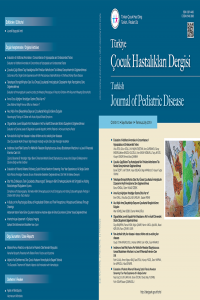Tekrarlayan Bronşioliti/Hışıltısı Olan Okul Öncesi Çocuklarda İmmünglobulin Düzeylerinin Hışıltı Fenotiplerine Göre Değerlendirilmesi
Abstract
Amaç: Tekrarlayan bronşiolit/hışıltı okul öncesi dönemde sık görülmektedir. Epizodik hışıltı ve çoklu tetikleyici hışıltı
fenotipleri tanımlanmıştır. Çalışmamızın amacı, epizodik hışıltı (EH) ve çoklu tetikleyici hışıltısı (ÇTH) olan çocukların
immünglobulin düzeylerinde fark olup olmadığını belirlemektir.
Gereç ve Yöntemler: Tekrarlayan bronşiolit/hışıltısı olan 4 yaş altındaki son bir yılda en az 3 bronşiolit/hışıltı atağı
geçirmiş olan çocuklar çalışmaya alındı. Hastalar fenotiplere göre epizodik ve çoklu tetikleyici hışıltı olarak iki grupta
incelendi. Eozinofil sayısı, eozinofil yüzdesi, immünglobulin (Ig) A, G, M düzeyleri kayıt edildi.
Bulgular: Tekrarlayan bronşioliti/hışıltısı olan 86 çocuk (55 erkek, 31 kız) çalışmaya alındı. IgA düzeyi EH (43.3±35 mg/
dl) olan grupta ÇTH grubuna (74.1±45.1 mg/dl) göre daha düşük bulundu (p<0.001). IgG düzeyi de EH grubunda
(565.4±173.7 mg/dl) ÇTH grubuna (769.9±198.8 mg/dl) göre daha düşüktü (p<0.001). İmmünglobulin düşüklüğü sıklığı
EH grubunda (n=12, %37.5) ÇTH grubuna (n=4, %7.4) göre daha fazlaydı (p<0.001).
Sonuç: Tekrarlayan bronşiolit/hışıltısı olan çocuklarda immünglobulin düzeylerine bakılmalı ve takip edilmelidir. Epizodik
hışıltıda immünglobulin seviyelerindeki düşüklüğün de enfeksiyon sıklığını arttırarak hışıltıya yatkınlığa neden olabileceğini
düşündürmektedir.
Keywords
References
- 1.Martinez FD, Wright AL, Taussig LM, Holberg CJ, Halonen M, Morgan WJ. Asthma and wheezing in the first six years of life. The Group Health Medical Associates. N Engl J Med 1995;332:133-8.
- 2. Whelan MA, Hwan WH, Beausoleil J, Hauck WW, McGeady SJ. Infants presenting with recurrent infections and low immunoglobulins: characteristics and analysis of normalization. J Clin Immunol 2006;26:7-11.
- 3. Kocacık Uygun DF, Filiz S, Yeğin O. Süt çocukluğunun geçici hipogamaglobulinemi ön tanılı olgularımızın değerlendirilmesi. J Pediatr Res 2015;2:128-33.
- 4. Taussing LM, Wright AL, Holberg CJ, Halonen M, Morgan WS, Martinez FD, et al. Tuscon Children’s Respiratory Study: 1980 to present. J Allergy Clin Immunol 2003; 111:661-75.
- 5. Brand PL, Baraldi E, Bisgaard H, Boner AL, Castro-Rodriguez JA, Custovic A, et al. Definition, assessment and treatment of wheezing. Eur Respir J 2008;32:1096-110.
- 6. Tezcan I, Berkel AI, Ersoy F, Sanal O. Serum immunoglobulin levels with turbidimetric method in healthy Turkish children and adults. Turkish J Pediatr Dis 1996;39:649-56.
- 7. Castro-Rodriguez JA. The Asthma Predictive Index: A very useful tool for predicting asthma in young children. J Allergy Clin Immunol 2010;126:212-6.
- 8. Guilbert TW, Morgan WJ, Krawiec M, Lemanske RF. The Prevention of Early Asthma in Kids study: design, rationale and methods for the Childhood Asthma Research and Education network. Control Clin Trials 2004;25:286-310.
Abstract
References
- 1.Martinez FD, Wright AL, Taussig LM, Holberg CJ, Halonen M, Morgan WJ. Asthma and wheezing in the first six years of life. The Group Health Medical Associates. N Engl J Med 1995;332:133-8.
- 2. Whelan MA, Hwan WH, Beausoleil J, Hauck WW, McGeady SJ. Infants presenting with recurrent infections and low immunoglobulins: characteristics and analysis of normalization. J Clin Immunol 2006;26:7-11.
- 3. Kocacık Uygun DF, Filiz S, Yeğin O. Süt çocukluğunun geçici hipogamaglobulinemi ön tanılı olgularımızın değerlendirilmesi. J Pediatr Res 2015;2:128-33.
- 4. Taussing LM, Wright AL, Holberg CJ, Halonen M, Morgan WS, Martinez FD, et al. Tuscon Children’s Respiratory Study: 1980 to present. J Allergy Clin Immunol 2003; 111:661-75.
- 5. Brand PL, Baraldi E, Bisgaard H, Boner AL, Castro-Rodriguez JA, Custovic A, et al. Definition, assessment and treatment of wheezing. Eur Respir J 2008;32:1096-110.
- 6. Tezcan I, Berkel AI, Ersoy F, Sanal O. Serum immunoglobulin levels with turbidimetric method in healthy Turkish children and adults. Turkish J Pediatr Dis 1996;39:649-56.
- 7. Castro-Rodriguez JA. The Asthma Predictive Index: A very useful tool for predicting asthma in young children. J Allergy Clin Immunol 2010;126:212-6.
- 8. Guilbert TW, Morgan WJ, Krawiec M, Lemanske RF. The Prevention of Early Asthma in Kids study: design, rationale and methods for the Childhood Asthma Research and Education network. Control Clin Trials 2004;25:286-310.
Details
| Primary Language | Turkish |
|---|---|
| Subjects | Internal Diseases |
| Journal Section | ORIGINAL ARTICLES |
| Authors | |
| Publication Date | July 30, 2019 |
| Submission Date | July 27, 2018 |
| Published in Issue | Year 2019 Volume: 13 Issue: 4 |
Cite
The publication language of Turkish Journal of Pediatric Disease is English.
Manuscripts submitted to the Turkish Journal of Pediatric Disease will go through a double-blind peer-review process. Each submission will be reviewed by at least two external, independent peer reviewers who are experts in the field, in order to ensure an unbiased evaluation process. The editorial board will invite an external and independent editor to manage the evaluation processes of manuscripts submitted by editors or by the editorial board members of the journal. The Editor in Chief is the final authority in the decision-making process for all submissions. Articles accepted for publication in the Turkish Journal of Pediatrics are put in the order of publication taking into account the acceptance dates. If the articles sent to the reviewers for evaluation are assessed as a senior for publication by the reviewers, the section editor and the editor considering all aspects (originality, high scientific quality and citation potential), it receives publication priority in addition to the articles assigned for the next issue.
The aim of the Turkish Journal of Pediatrics is to publish high-quality original research articles that will contribute to the international literature in the field of general pediatric health and diseases and its sub-branches. It also publishes editorial opinions, letters to the editor, reviews, case reports, book reviews, comments on previously published articles, meeting and conference proceedings, announcements, and biography. In addition to the field of child health and diseases, the journal also includes articles prepared in fields such as surgery, dentistry, public health, nutrition and dietetics, social services, human genetics, basic sciences, psychology, psychiatry, educational sciences, sociology and nursing, provided that they are related to this field. can be published.


